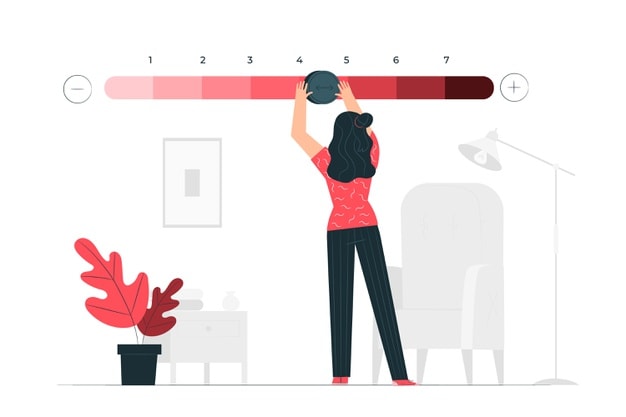The graphic rating scale is the type of appraisal method in which the expected behavior of all traits for effective performance is listed for every employee, and his performance is rated against these traits.
Table of Contents
What is the Graphic Rating Scale?
The primary objective of this course is to categorize every employee into different performance tiers. It is primarily done to determine salary adjustments and promotions or, in some cases, even lateral job movements.
The graphic rating is used to measure a broad range of employee behaviors. Behaviors that are required for the job efficiency of the employee are measured. Commonly, taking initiatives, meeting deadlines, working well in teams are a few of the traits which are measured; however, they may differ depending on industry, company, department, and role.
In most cases, the rating consists of all the criteria like 2 ratings for personal competence, 2 for personal goals or objectives, 1 rating for departmental goal, and 2 for overall organizational objectives.
Formatting a Graphic Rating Scale
There are multiple ways to draft a graphic rating scale. It is at the sole discretion of the employer and the employee’s needs, which will determine the drafting of the rating scale.
In any case, there will be a rating scale with two extremes. Following are a few of the standard formats of the graphic rating scale:
1. Number scale
The number scale consists of number ratings. This rating can be from 1 to 5 or 1 to 10. Rating 1 specifies that improvement is needed, and 10 is perfect. The disadvantage of this type of scale is that it focuses on behavioral traits that may not be specific to all the jobs.
The organization should develop specific criteria which can save it in legal costs.
2. Word scales
Word skills consist of the performance-related terms which define and rate the performance of the employee. For example, the rating scale may be categorized into Poor, fair, good, and excellent.
3. Comment scales
The comment scales are short lines or long lines of comments which are given to the employee.
However, the comments should be standard and common for all. For example, Meets expectations, below expectations, above average, etc. Sometimes the comments can be sentences as well.
4. Mixed standard scale
In this scale, there are mixed statements that represent average, excellent, and poor performance. The supervisor is asked to rate a plus (+), zero (0), or minus (-), which means above average, average, and below-average, respectively.
Characteristics of a Good Graphic rating scale
- The graphic rating scale varies by company, industry, and department. It is essential that whatever may be the case, the scales must be based behaviourally.
- The evaluation criteria against which the employees are rated should be adequately defined so that it is the same for all employees.
- Definitions that send mixed messages or present yourself as ambiguous should be avoided. Honesty, loyalty, etc. are vague terms and send mixed messages, and therefore they should not be used in the rating scale.
- The scale should be exact and accurate so that the employee knows his ranking or points or rating. It should never be a rounded or overall figure.
- The ratings should be relevant to the behavior which is measured. For example, to measure leadership, ratings should be performance-oriented, balanced, laissez-faire, or people-friendly, etc.
Advantages of Graphic Rating Scale Method
- Whichever method of graphic scale is used to measure performance, it should be clear and understandable by both the employee and the manager. It should have proper definitions of the terms explained in it without misunderstandings.
- There should be standardization of all the comparison criteria
- All the behaviors should be numerically quantified. It makes the appraisal system easy to execute and compare it with others. Also, it is easier for the organization to group employees with the same ratings in similar groups.
Disadvantages of Graphic Rating Scale Method
- The ratings may or may not be accurate, as the perception of the judges. Every judge will have a different perspective when it comes to rating the behaviors.
- Most of the time, the ratings are difficult to give since labels such as difficult or tricky since the rating scale do not exemplify the ideal behaviors.
- Various perception issues like the halo effect, recency effect, etc. can be difficult to rate, and they often lead to incorrect ratings. This is primarily because of perception issues.
- The graphic rating scale method is excellent when it comes to pointing out excellent or top performers and unfit employees. The extremes are categorized and separated easily, but the issue comes with differentiating average employees. It cannot distinguish between two employees who are average and close to each other but are different in performance by slight variations.
- The other limitation of the graphic rating scale is that it is not effective when it comes to knowing the employee’s strengths. Different strong characteristics may be present with different employees, and these are not considered separately. This causes them to qualify for the same score despite having differences.
Conclusion
Graphic rating scale method is an excellent form of measuring performance management and gives more accuracy as compared to others. Many industries utilize this method, and it gives them pretty good results.
However, care should be taken that the scale is designed correctly and considers the employees for their jobs and nature of duties, and rates them accordingly. Although there are a few limitations, it still is one of the best methods to measure employee performance.
Liked this post? Check out the complete series on Human resources

